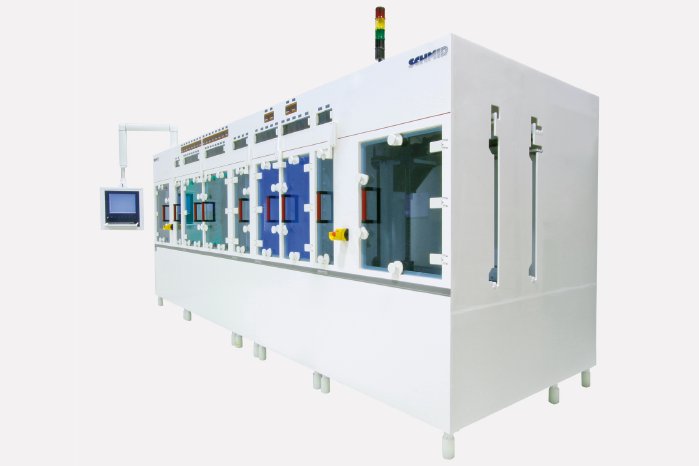- Homogeneous process results by symmetric chemical treatment on both sides
- Integrated contact-free inline clamping transport for ultra-thin core down to 25μm thickness
- Fine line etching capability down to 25μm lines and spaces
- Panel sampling in Zhuhai Technology Center
SCHMID has foreseen the PCB market's growing need for high accuracy etching and handling solutions facing ever decreasing line width and spacing as well as panel thickness down to 25μm. The development team in Zhuhai has thought outside the box and worked diligently to present the Vertical DES Line (Developing/Etching/Stripping) that meets current market requirements and outperforms any competitors.
Besides the whole DES line, SCHMID also provides vertical stand-alone machines for developing, etching and stripping as well as for flash etch processing, soldermask developing and precleaning.
Vertical processing has many considerable advantages such as less footprint compared to horizontal lines, a service-friendly design and full inline automation. Most notably vertical processing allows a double-sided symmetric chemistry treatment by identical process conditions on both sides of the substrate. This is especially beneficial in etching: by using a special chemistry that only is effective when hitting the substrate, the process result is absolutely homogeneous and the well-known puddling effect that occurs in horizontal etching is completely eliminated. Still up to today elaborate intermittent spraying techniques are necessary in trying to compensate this puddling effect.
Furthermore, the contact-free clamping transport perfectly protects ultra-fine lines during the fine line etching process. These lines could be damaged or peeled off in standard horizontal conveyor processing by minimum oscillation of the conveyor system or by any roller contact. Therefore SCHMID offers clamping systems already for its horizontal lines. Contact-free handling without human intervention pays off in substantial yield increase.
SCHMID has offers multiple vertical and also horizontal clamping systems for a wide range of panel sizes because of the flexible lengths that are possible in running direction. Panel sizes are only limited in width.

